|
Under the light of a Parasol Star
- The game -
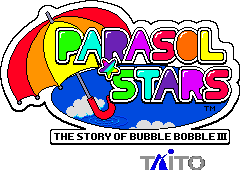 Parasol
Stars, also known as Parasol Henbei, is the third chapter of the Bubble Bobble series. Heroic Bub and Bob,
after setting the Rainbow Islands free, get ready for a new adventure. Armed with magical parasols (received as gifts
from the islands inhabitants grateful because of their success) they have to save ten planets from ten giant enemies. Each
world is composed of seven rounds... seventy levels total! Parasol
Stars, also known as Parasol Henbei, is the third chapter of the Bubble Bobble series. Heroic Bub and Bob,
after setting the Rainbow Islands free, get ready for a new adventure. Armed with magical parasols (received as gifts
from the islands inhabitants grateful because of their success) they have to save ten planets from ten giant enemies. Each
world is composed of seven rounds... seventy levels total!
Parasols have an incredible power: they can stop bullets; lift enemies, throw them far away, making them fall in a coma and
finally crush them; collect water-filled bubbles and create falls which will catch all they find on their path (do you
remember the Liquid Kids game? It was published in 1990, and its character threw the same sort of bubbles to
enemies... exactly like in Parasol Stars). This is a genuine plaformer, offering the chance to enjoy a 2-players
co-operative mode exactly as Bubble Bobble (1986) and Don Doko Don (1989), but enriched by funny enemies - a
few brand new and others imported by other Taito videogames. For example there's the fearful presence of Doh, coming
directly from Arkanoid. A few enemies of these will appear again in two other games of the series: Bubble
Memories and Bubble Symphony. Area bosses are giantic, funny and similar to what we already saw in Rainbow
Islands. The soundtrack is composed of happy tunes and sound effects, which we can hear during the whole play. Bonuses,
magical doors and useful items are hidden all around the game areas.
- The mystery of the title -
We can read a strange subtitle in the colourful and pretty main game screen: "The Story of Bubble
Bobble III". We can notice that also Bubble Memories has the same subtitle... maybe someone made a little bit
confusion?
Chronologically speaking, Bubble Memories was released in 1995, so it should have been the sequel to Parasol
Stars, and its subtitle should be "The Story of Bubble Bobble IV". The Amiga and Atari ST versions were
published by Ocean Software, a software-house from Manchester. They solved the problem by placing the subtitle as
"Rainbow Islands II" - the GameBoy version actually kept the "Bubble Bobble III" title in the game,
while showing "Rainbow Islands II" on the box.
This was a wise solution to avoid any kind of mistakes. But Ocean managers would never figure that Bubble
Memories would see the light three years later... so why did they change titles and subtitles? Why didn't they change
the Nintendo version subtitle?
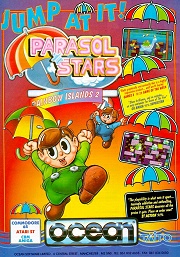 |
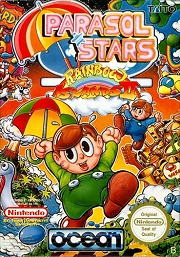 |
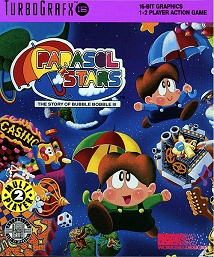 |
| The C64/Amiga/Atari ST flyer |
The NES version box |
The PCE/Turbo GraFX 16 box |
- The legend -
The existance of the arcade version of this videogame has become a sort of legend, not that much different
than the story of Atlantis. It's really obscure, and no one seem to know whether it's ever existed or not: some people swear
they saw it for real, and "authentic" pictures can be found on few Internet sites, showing the first stage of the
game. But how many times did we see "true" pictures of this or that, showing aliens coming from outer spaces, or
flying saucers across the sky? Too many times for sure - and they were nothing but well-done jokes! Yes, maybe E.T. life
exists but we can't demonstrate that now... in a similar way we can't demonstrate the existance of the Parasol Stars
coin-op.
Taito managers themselves never admitted they produced an arcade version of the masterpiece; also, the title doesn't
appear on the list of released coin-ops by the Japanese manufacturer (so this might be an expanation to the mysterious
dualism of the title: one of the two has never officially existed).
Strangely enough, why do they speak of "conversions to Home Computers" of the world-famous inexistent arcade? It
was "ported" to all the most common computers in those years: NEC PC-Engine/Turbo GraFX 16, Commodore Amiga, Atari
ST, Nintendo NES and GameBoy. The former was developed by Working Design studios in 1991, and the others by Ocean
Software (which already converted Rainbow Islands in 1990) in 1992.
The reason why Taito never released the coin-op is still one of the greatest misteries of the videogaming scene -
people say a few prototypes were available in some amusements for beta-testing. Who knows the truth?
- The theft -
|
 Due to the
huge success of the Bubble Bobble and Rainbow Islands conversions to home computers (Firebid, 1987 and
Ocean Software, 1991), all videogamers waited the C64 version of Parasol Stars. In 1992 Ocean Software (now
belonging to Infogrames) announced the forthcoming release of the videogame but... the game main programmer, who was
about to complete the project, was robbed. A thief stole his computers and software from his house, including the
source code of the game. It would have required too much effort to start again, so the project was deleted. Due to the
huge success of the Bubble Bobble and Rainbow Islands conversions to home computers (Firebid, 1987 and
Ocean Software, 1991), all videogamers waited the C64 version of Parasol Stars. In 1992 Ocean Software (now
belonging to Infogrames) announced the forthcoming release of the videogame but... the game main programmer, who was
about to complete the project, was robbed. A thief stole his computers and software from his house, including the
source code of the game. It would have required too much effort to start again, so the project was deleted.
|
- Portings in existance -
The PC-Engine/Turbo GraFX 16 version is undoubtfully the best porting - the console is well known because
of the high quality of conversions from coin-ops. It was the first released version, and was programmed by Californian
software house Working Designs. It has a superb playability, perfectly-balanced difficulty, wonderful graphic effects,
colourful and beautiful sprites, plus great sound quality. It looks like we're actually playing a true coin-op not a
console!
The Amiga version lacks a bit of playability, and the game also pauses during levels loading. Graphics and sounds are really
great.
Atari ST, another popular Home Computer featuring the M68000/8MHz microprocessor (similar hardware to Amiga) features a
really beautiful version of Parasol Stars. Similar graphics and sounds to the Amiga version but having a better playability.
Both versions suffer from the "1-button joystick syndrome" which force the player to pull joystick up to make
characters jump, while the parasol is operated by pressing the button.
The Nintendo NES porting is the worse one... Nice audio and average graphics, while the overall game quality is poor indeed,
and it looks like it's been done in great hurry. The GameBoy version is really entertaining: it seems a miracle to see what
they could do with just four colours, and a single audio speaker! It keeps a real arcade atmosphere. What a pity it
immediately becomes too much hard - that will make you put the game apart soon.
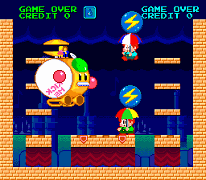
NEC PC-Engine/Turbo GraFX 16
|
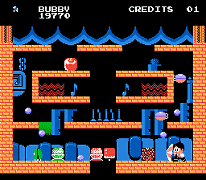
Nintendo NES
|
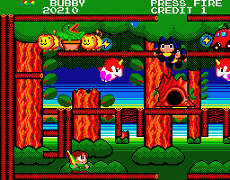
Atari ST
|
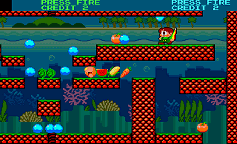
Commodore Amiga |
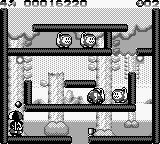
Nintendo GameBoy |
- Finally... -
If only we could play it as a coin-op, we'd probably play it more and more, and consider it as another
classic videogame as Bubble Bobble and all of its successors. Unfortunately, due to unknown business issues,
Taito denied us that pleasure... but we can still enjoy the wonderful porting available on PC-Engine/Turbo GraFX 16.
Zaxxon1
|
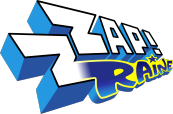





 Parasol
Stars, also known as Parasol Henbei, is the third chapter of the Bubble Bobble series. Heroic Bub and Bob,
after setting the Rainbow Islands free, get ready for a new adventure. Armed with magical parasols (received as gifts
from the islands inhabitants grateful because of their success) they have to save ten planets from ten giant enemies. Each
world is composed of seven rounds... seventy levels total!
Parasol
Stars, also known as Parasol Henbei, is the third chapter of the Bubble Bobble series. Heroic Bub and Bob,
after setting the Rainbow Islands free, get ready for a new adventure. Armed with magical parasols (received as gifts
from the islands inhabitants grateful because of their success) they have to save ten planets from ten giant enemies. Each
world is composed of seven rounds... seventy levels total!


 Due to the
huge success of the Bubble Bobble and Rainbow Islands conversions to home computers (Firebid, 1987 and
Ocean Software, 1991), all videogamers waited the C64 version of Parasol Stars. In 1992 Ocean Software (now
belonging to Infogrames) announced the forthcoming release of the videogame but... the game main programmer, who was
about to complete the project, was robbed. A thief stole his computers and software from his house, including the
source code of the game. It would have required too much effort to start again, so the project was deleted.
Due to the
huge success of the Bubble Bobble and Rainbow Islands conversions to home computers (Firebid, 1987 and
Ocean Software, 1991), all videogamers waited the C64 version of Parasol Stars. In 1992 Ocean Software (now
belonging to Infogrames) announced the forthcoming release of the videogame but... the game main programmer, who was
about to complete the project, was robbed. A thief stole his computers and software from his house, including the
source code of the game. It would have required too much effort to start again, so the project was deleted.













